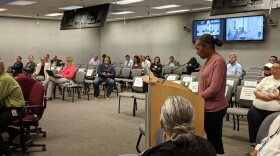On Monday, the San Joaquin Valley Air Pollution Control District issued a warning of unhealthy air conditions due to wildfire smoke from Northern California, an alert it repeated on Wednesday. Why then, for days, were online air monitors showing relatively healthy air? It’s the result of the size of the particulate matter blowing into the Valley, but also the level of information that air authorities share with the public.
Since late last week, smoke blown south from the Kincade Fire and dust kicked up by strong winds have turned the sky in some parts of the San Joaquin Valley a murky brownish gray. “We basically have a perfect storm of unusual circumstances that is making the air quality very unusual for the Valley,” says air district spokesperson Jaime Holt.
And yet, over the weekend and into the earlier part of the week, both regulatory air monitors with the air district and consumer monitors by the citizen science company Purple Air were registering moderate, even mild conditions. That’s because the universal measure of air quality, called the Air Quality Index (AQI), is typically calculated based on concentrations of ozone and fine particulate matter known as PM2.5. However, some particulates in dust and ash, categorized as PM10, are too large to be picked up by detectors for the tinier, more common PM2.5.
That’s not to say that PM10 is not measured. Nearly half of the 39 air monitors the air district has distributed throughout the Valley detect PM10, and yet the district’s real-time air advisory network (RAAN) highlights only ozone and PM2.5. Conversely, although PM10 concentrations are an optional data layer on Purple Air’s user-friendly map, reported levels fall far below what’s being picked up by regulatory air monitors. On Sunday, PM10 levels in Fresno, Kern, Tulare and Kings Counties all topped 700 micrograms per cubic meter. The EPA rates anything above 200 to be “very unhealthy.”
Each family of particles comes with its own health implications. The smaller PM2.5 particles can make their way into the bloodstream and are associated with cardiovascular problems and reduced birth outcomes, while the larger PM10 particles primarily pose respiratory risks. “If someone has COPD or asthma, they’re going to see more of an impact from the PM10, because it’s really going to trigger them and they’re going to have a difficult time breathing,” says Holt.
So where can reliable PM10 data be found? With either California Air Resources Board’s Air Quality Meteorological Information System or the Environmental Protection Agency’s AirNow tool—both of which happen to source their data from those 39 Valley air monitors the air district uses. “They’re the exact same monitors,” says Genevieve Gale, Executive Director of the non-profit Central Valley Air Quality Coalition. “And so it’s just a matter of what information is made public”
Gale, a Fresno resident, agrees the dismal air quality over the weekend was confounding. “It was a confusing weekend where the normal sources of information were telling me one thing but my senses were telling me another,” she says. She knew to look outside the air district for data on pollutants beyond PM2.5 and ozone, but she’s aware most people won’t have those websites and apps at their fingertips.
Even though spikes in PM10 concentrations happen so rarely, Gale wishes the pollutant had been on the radar of both air officials and advocates like herself. “I see that as a blind spot and something that needs to be fixed as we move forward,” she says.
Still, Gale argues more proactive, urgent messaging from the air district could have prevented many of the sports practices and outdoor classes that she hopes will be cancelled the next time this kind of anomaly happens. “If the air district doesn’t learn from this, it’s definitely on them,” she says, especially considering that bigger wildfires and windier conditions are being forecasted as California’s “new normal.”
In its emails to the public, the air district warns that dust and smoke that can be seen or smelled should be considered unsafe. “If an area is covered in ash or dust, air quality should be considered ‘unhealthy’ (RAAN Level 4 or higher) even if the monitor reflects a lower reading,” the air district’s Wednesday alert reads. Air officials expect blowing dust to subside by Thursday, but for smoke impacts to continue as long as the fires continue to burn.






